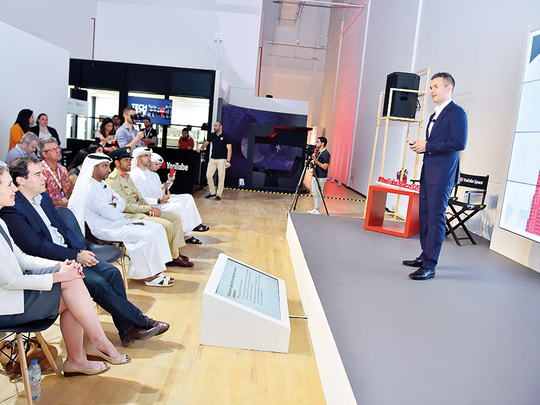
Dubai
YouTube on Sunday opened a 6,000-square-feet office space in Dubai Studio City in an effort to give a boost to content creators in the Middle East and North Africa (Mena).
Called YouTube Space Dubai, the facility has two studios, which measure close to 1,975 square feet of total space, a training room, artwork, control room, production facilities room, etc. YouTube says it is an incubator space that will give content creators the tools and guidance and enable them to innovate and experiment.
Dubai became the 10th destination for the YouTube Space and first in Mena. The other destinations are in Los Angeles, London, Tokyo, New York City, Berlin, Sao Paolo, Mumbai, Toronto and Paris.
Subscribers a content creator needs to have access to equipment and studios
The biggest space is in Los Angeles with 40,000 square feet.
Robert Kyncl, chief business officer at YouTube, said that there are more than 200 creators with over one million subscribers and over 30,000 creators with more than 10,000 subscribers in the region, out of which 25 per cent are women.
“Number of channels uploading from the region has grown by 160 per cent in the past three years. The region has one of the world’s most vibrant YouTube communities in the world,” he said.
David Ripert, Head of YouTube Spaces in Europe, Middle East, and Africa, said that the space is for creators to connect, learn and create.
He said the facility will offer YouTube content creators free access to high-end audio, visual and editing equipment in addition to training programmes and workshops.
To get access to the equipment and studios, he said the creator needs to have more than 10,000 subscribers, while channels with 1,000 subscribers or more will only have access to the workshops and events held at the space.
Without those requirements, he said there would be too much demand for the space. He said there are other resources like ‘Creator Academy” that people can use online and to build up their audiences before they come here.
“There is a revenue split between the content creator and YouTube in general. Creators make money from advertising,” he added.
“Many people from the region used to visit the UK space to create Arabic content and now with the Dubai facility, it is easy for the creators to save time. As a platform, YouTube provides a blank canvas for creative expression and the space will be one of the tools creators use to tell their own stories,” he said.
He said YouTube has more than 100,000 square-feet of studios globally and more than 440,000 creators have visited nine YouTube Spaces around the world since the Spaces programme first launched in 2012.
When asked how the new rule for content creators to have licences to operate in the UAE will impact the industry, Majed Al Suwaidi, managing director of Dubai Studio City, said that more clarity is needed, but the new rules will add more credibility to the creators.
Maha Jaffar, a dentist from Dubai and a YouTuber, better known for imitating accents and stereotypes from various Arab countries, said that she happened to join YouTube by coincidence and her first video, which she sent it to my friends, went viral.
“Then, I decided to open my own channel. I am still a dentist but YouTube gives me a beautiful world to connect with my followers, spread culture and promote love between people,” she said.










